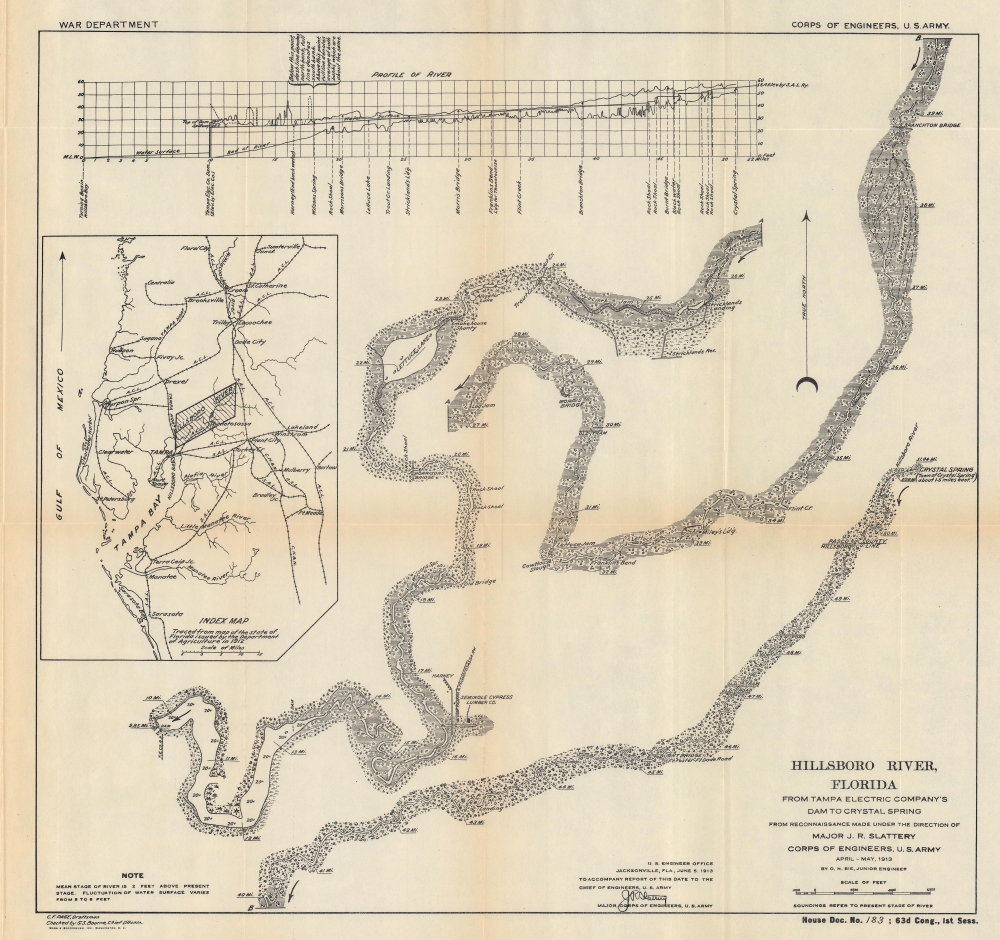This item has been sold, but you can get on the Waitlist to be notified if another example becomes available, or purchase a digital scan.
1913 U.S. Army Corps of Engineers Map of the Hillsborough River, Florida
HIllsboroRiverHouseDoc-bie-1913
Title
1913 (dated) 18 x 18.675 in (45.72 x 47.4345 cm) 1 : 22000
Description
A Closer Look
The map covers some 40 miles of the Hillsborough River from Crystal Spring to the Tampa Electric Company Dam. The river is broken into three roughly parallel sections to accommodate a single sheet. Milage along the river is noted with depth soundings provided. Bridges, roads, trams, railroads, and fords are marked. An index map in the upper left illustrates the region from Floral City to Sarasota, situating the depicted portion of the Hillsborough River in a wider geographical context. This index map also details the railroad network, including the Atlantic Coast Line Railroad and the Seaboard Air Line Railroad.Publication History and Census
This map was created from a survey undertaken by Otto N. Bie under the direction of John R. Slattery, drafted by C. F. Page, and published as part of the Chief of Engineers, U.S. Army report to the U.S. Congress in 1913. This is the only known cataloged example of the separate map in the present edition. Another edition, not bearing the House Document Number, is part of the Touchton Map Library at the Tampa Bay History Center.CartographerS
Otto Norman Bie (September 24, 1859 - July 22, 1930) was a Norwegian engineer. Born in Norway, Bie sailed the seas as a sailor on his father's fleet of square riggers. His first voyage took him to India, and he continued sailing, first arriving in the United States in Jacksonville, Florida, in 1882. After a return to Norway, Bie returned to Florida in 1886 and stayed for the rest of his life. He found work on a dredge scooping out channels, liked the work, and continued, eventually becoming the master of the dredge Suwanee. During his time as captain of a dredge, Bie opened channels into Tampa, the Suwanee and Indian rivers, and Cedar Keys. Captain Bie joined the U.S. engineer's office in Tampa in 1906. Captain Bie spent from 1908 through 1910 in Miami in charge of government harbor improvements there. He was transferred to Tampa in January 1910, where he was put in charge of the office, named junior engineer, and oversaw improvements to that harbor. He spent the rest of his life in Tampa, slowly rising through the ranks as a civilian (not common in the Corps of Engineers). Eventually, he was in charge of the U.S. Army Corps of Engineers' Tampa District, and oversaw the U.S. Army Corps of Engineers' river and harbor work along the west coast of Florida from 1910 until his death in 1930. He was well respected throughout Florida and was often brought in as a consulting engineer on projects throughout the state. He was married twice, first to Martha Ellen (Townsend) Bie and then to Mrs. Hollon Bie. He had two sons with Martha Ellen. More by this mapmaker...
Colonel John R. Slattery (January 31, 1877 - September 23, 1932) was an American engineer, Army officer, and public servant. Born in Athens, Ohio, Slattery attended and graduated from public schools in Cincinnati before entering the United States Military Academy at West Point. He graduated from West Point in 1900, was commissioned a second lieutenant, and entered the U.S. Army Corps of Engineers. He spent the next 25 years in the Corps of Engineers. He spent 3 years in charge of the Honolulu district in Hawaii, where he worked on coastal defense plans and ways to improve the Honolulu and Hilo harbors. Then he worked on several projects in Kansas before being sent to Florida to oversee coastal defenses at Key West and Tampa Bay as well as improvements to rivers and harbors throughout the state. He also worked as the district manager of the Mississippi Delta region during his career, overseeing levee and bank revetment work. During World War I Slattery served with the 312th Engineers in Bordeaux, France, where he was in charge of coordinating the handling of supplies and the hospitalization of troops. After returning to the United States, he was assigned to the Seventh Army Corps (in charge of Columbia River improvements) as chief engineer. He became district engineer in charge of all river and harbor improvements in New York State in 1923. While in New York, he was convinced to join the New. York City Board of Transportation, which he joined on April 1, 1925, as deputy chief engineer. He also became general manager of the Independent Rapid Transit System. He was general manager when the Eighth Avenue Subway opened and his doctor stated that overwork dealing with the opening of the Eighth Avenue Subway directly caused Slattery's death. He married Elizabeth Bradley, with whom he had three children. Learn More...

